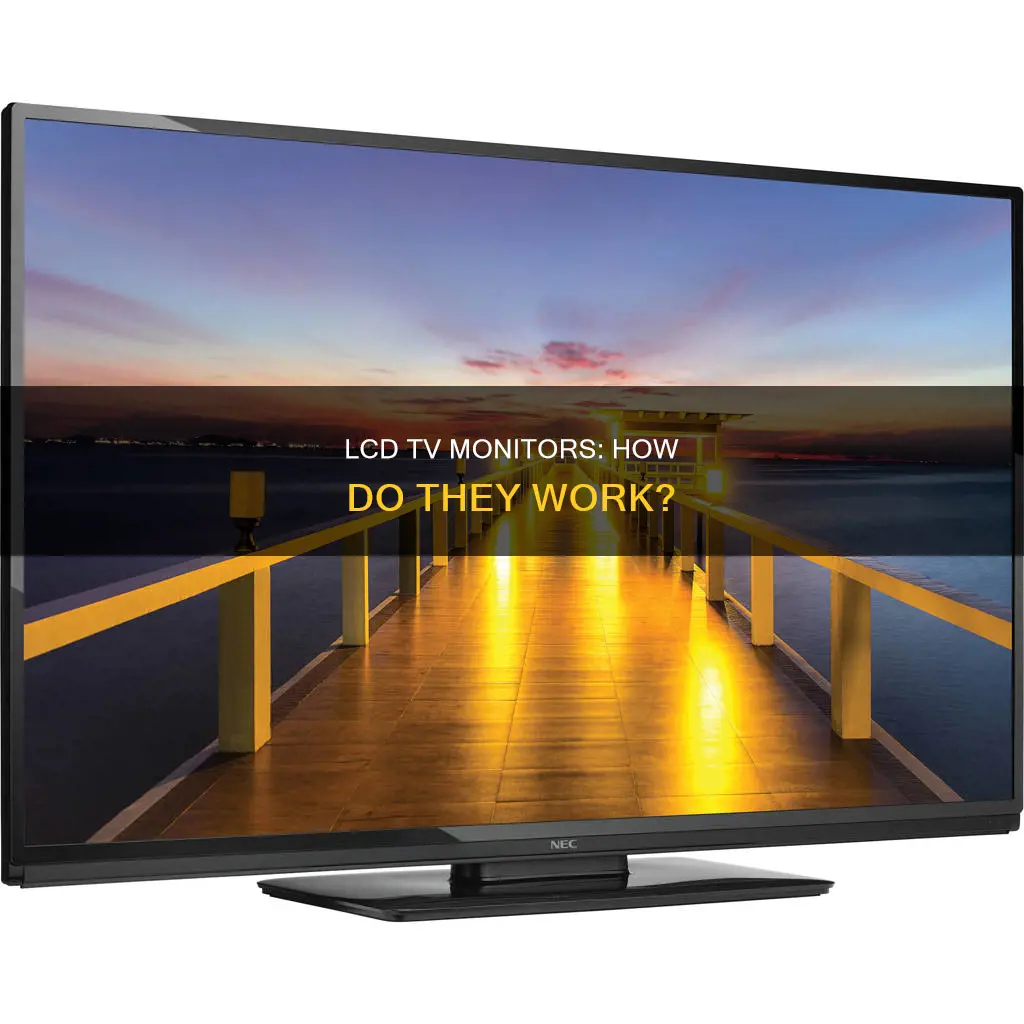
LCD stands for Liquid Crystal Display. LCD monitors are flat-panel displays that use liquid crystal technology to produce images. They are thinner, more compact, and more lightweight than traditional computer monitors, with higher resolution and crisper visuals. LCD monitors use cold cathode fluorescent lamps (CCFLs) for backlighting, which illuminate the screen and allow the passage of light through the liquid crystals to create images.
| Characteristics | Values |
|---|---|
| Type | Flat-panel display |
| Technology | Liquid crystals |
| Lighting | Backlight |
| Image | Made up of pixels |
| Pixels | Made up of three subpixels (red, green, and blue) |
| Backlight | Cold cathode fluorescent lamps (CCFLs) |
| Thickness | Thinner than cathode ray tube (CRT) technology |
| Power consumption | Low |
| Image quality | Good colour reproduction and brightness |
| Lifespan | 30,000 to 60,000 hours |
What You'll Learn
- LCD monitors are a type of flat-panel display that uses liquid crystals to create images on a screen
- LCD screens are thinner and more compact than traditional monitors, making them ideal for hanging in conference rooms or raising up to provide more desk space
- LCD monitors use cold cathode fluorescent lamps (CCFLs) for backlighting, whereas LED monitors use light-emitting diodes
- LCD screens have a faster response time and higher refresh rate, making them a good choice for gaming
- LCD screens are more susceptible to burn-in marks from images left on the screen for extended periods

LCD monitors are a type of flat-panel display that uses liquid crystals to create images on a screen
LCD monitors, or Liquid Crystal Displays, are a type of flat-panel display that uses liquid crystals to create images on a screen. This technology allows for thinner and more compact screens when compared to traditional computer monitors. LCD screens are backlit, with light passing through liquid crystals and colour filters to create an image.
LCD screens are made up of pixels, each consisting of three subpixels (red, green, and blue). When an electric current is applied, the liquid crystals align to allow or block light, creating the images we see on the display. This technology is different from LED screens, which use light-emitting diodes and do not require a separate light source.
LCD screens have several advantages over LED screens. They are often more affordable, have matte screens that reduce glare, and offer more consistent lighting across the entire screen. LCD screens also typically have a longer lifespan than LED screens, with CCFL backlights lasting around 30,000 to 60,000 hours compared to 50,000 hours for LEDs.
However, LED screens offer superior picture quality with better contrast ratios, deeper blacks, and more precise control over screen brightness. They also tend to be more energy-efficient, consuming 20-30% less power than LCD screens, which can result in lower electricity bills over time.
When choosing between LCD and LED monitors, it is important to consider factors such as purpose, budget, energy efficiency, and picture quality. For gaming, graphic design, or video editing, an LED monitor often provides better performance and colour accuracy. However, LCD monitors can still deliver a good gaming experience, especially if they have a high refresh rate.
Setting Up the ProArt 248Q: A Step-by-Step Guide
You may want to see also

LCD screens are thinner and more compact than traditional monitors, making them ideal for hanging in conference rooms or raising up to provide more desk space
LCD screens are also considerably lighter than traditional monitors, making them easier to transport and hang. Their lightweight design is a significant advantage over bulkier alternatives. The compact and lightweight nature of LCD screens makes them highly versatile, allowing users to position them in a way that suits their needs and maximises space efficiency.
In addition to their space-saving benefits, LCD screens offer improved image quality. The backlit pixels in LCD panels make the screen brighter, ensuring visibility in both well-lit and dark rooms. This feature enhances the viewing experience, particularly in environments with varying lighting conditions.
The borderless display featured on many LCD monitors is also advantageous. It preserves the image aspect ratio, preventing any cropping or distortion of the displayed content. This is especially beneficial for tasks requiring precise image representation, such as graphic design or photo editing.
Furthermore, LCD screens are known for their longevity. They are designed to prevent "burn-in" marks, which are ghost images left on screens that can occur on older model monitors. This extends the lifespan of LCD screens, making them a durable and cost-effective option.
Transforming LCD Monitors: TV Conversion Without a Tuner
You may want to see also

LCD monitors use cold cathode fluorescent lamps (CCFLs) for backlighting, whereas LED monitors use light-emitting diodes
LCD stands for Liquid Crystal Display. LCD monitors use cold cathode fluorescent lamps (CCFLs) for backlighting. CCFLs are long, thin tubes that produce light through the interaction of electricity with mercury vapour inside the tube. They are used as backlights in LCD monitors, laptops, and televisions. CCFLs are known for their long lifespan, high brightness, and low power consumption. They are also more energy-efficient than LED monitors.
LED monitors, on the other hand, use light-emitting diodes (LEDs) for backlighting. LEDs are semiconductors that generate light. LED monitors have several advantages over CCFL-backlit LCD monitors. They offer superior picture quality with better contrast ratios and deeper blacks. LED monitors also have longer lifespans, better colour accuracy, and improved visual clarity. Additionally, LED monitors are thinner and more energy-efficient than standard LCD monitors.
While LED monitors have many advantages, there are situations where LCD monitors with CCFL backlighting are preferred. LCD monitors are often more affordable, making them a good choice for budget-conscious buyers. They also typically come with matte screens, which reduce glare in bright environments. LCD monitors also have more uniform backlighting across the screen, resulting in consistent lighting. Furthermore, some users find that LCD monitors emit less blue light, potentially reducing eye strain.
In terms of eye comfort, both LCD and LED monitors can cause eye strain with prolonged use. However, LED monitors often have better brightness control and reduced flicker, especially in higher-end models. Many newer LED monitors also offer blue light filtering options.
When it comes to colour accuracy, LED monitors generally offer better performance due to their wider colour gamut. High-end LED monitors can display a larger percentage of the sRGB and Adobe RGB colour spaces. However, some professional-grade LCD monitors with IPS panels can also provide excellent colour accuracy.
In summary, while LED monitors have numerous advantages over LCD monitors with CCFL backlighting, LCD monitors still have their place in the market. They are more affordable, energy-efficient, and offer consistent lighting and good colour reproduction. Ultimately, the choice between LCD and LED monitors depends on specific needs, budgets, and intended use.
Finding Compact Monitors: Small-Sized Displays for Your Setup
You may want to see also

LCD screens have a faster response time and higher refresh rate, making them a good choice for gaming
LCD, or Liquid Crystal Display, is a type of flat-panel display that uses liquid crystals to create images on a screen. When an electric current is applied, the liquid crystals align to allow or block light, creating the images you see on the display. LCD screens are commonly used in televisions, computer monitors, and smartphones.
The refresh rate of an LCD screen, on the other hand, refers to the number of times per second that the display updates the image on the screen and is measured in hertz (Hz). A higher refresh rate allows the display to show more frames per second, resulting in smoother and more realistic motion. This can provide an advantage in gaming by improving reaction time and accuracy.
In addition to their fast response times and high refresh rates, LCD screens also offer good color reproduction, brightness, and energy efficiency. They are typically thinner and more energy-efficient than older CRT monitors. However, when compared to LED screens, LCD screens may struggle with producing true blacks and often have less uniform backlighting.
Asus Monitor Cleaning: A Step-by-Step Guide
You may want to see also

LCD screens are more susceptible to burn-in marks from images left on the screen for extended periods
LCD burn-in occurs when a static image is displayed on the screen for an extended period, causing the pixels to degrade and display incorrect colors. This results in a faint but permanent ghost image on the screen, which is particularly noticeable against a plain background. It is important to distinguish LCD burn-in from image retention, which is temporary and reversible. LCD burn-in is permanent and cannot be reversed, whereas image retention is a temporary issue where an image remains on the screen even after it should have disappeared.
The key to preventing LCD burn-in is to avoid displaying static images for long periods. This can be achieved by using screensavers or power-saving modes that dim or turn off the display when not in use. Additionally, reducing the brightness and contrast settings can help mitigate the risk of burn-in. It is also important to manage other factors that contribute to LCD burn-in, such as high brightness levels and high ambient temperatures, which can accelerate the degradation of pixels.
While LCD screens are more susceptible to burn-in marks than older CRT displays, it is important to note that burn-in is still a rare occurrence on LCD screens. It requires constant abuse or extreme settings to cause permanent image burn-in on an LCD screen. However, it is crucial to take preventive measures to maintain the quality and performance of LCD screens and avoid premature replacement.
To summarize, LCD screens are at risk of burn-in marks from static images, but this can be mitigated through proper maintenance and preventive strategies. By understanding the causes and effects of LCD burn-in, users can take the necessary steps to prolong the lifespan and maintain the optimal performance of their LCD screens.
Enabling Audio on Your ASUS Monitor: A Simple Guide
You may want to see also
Frequently asked questions
An LCD (Liquid Crystal Display) monitor is a flat-panel display that uses liquid crystal technology to produce images. LCD monitors are typically thinner, more energy-efficient, and offer better colour reproduction and brightness compared to older CRT monitors.
LCD monitors use liquid crystals, which are substances with properties of both liquids and solids. When an electric current is applied, the liquid crystals align to allow or block light, creating the images displayed on the screen.
LCD monitors offer several advantages, including thinner and more compact designs, reduced weight, borderless displays, brighter screens, and touch screen capability. They also help prevent "burn-in" marks on the screen, extending the life of the product.
There are two main types of LCD monitors: passive matrix and active matrix (or thin-film transistor - TFT) displays. Active matrix LCDs have a transistor at each pixel intersection, allowing for improved screen refresh times and lower power consumption.
LED (Light Emitting Diode) monitors are a type of LCD monitor that use LEDs for backlighting, offering superior picture quality, improved energy efficiency, and longer lifespans. LED monitors are generally more expensive than LCD monitors but provide better performance and have become the preferred choice for many consumers and manufacturers.







